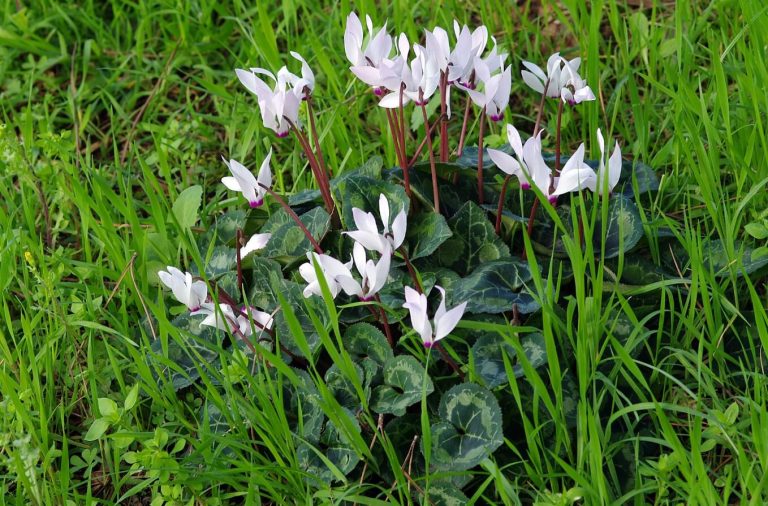The comprehensive guide about How to Care for Persian Cyclamen
The Persian cyclamen (Cyclamen persicum) is a stunning winter-blooming houseplant that can live for many years with proper care. This compact flowering plant is native to the Middle East and enjoyed by gardeners for its bright blossoms and attractive foliage.
Caring for cyclamen plants is easy once you understand their growth habits and needs. This guide covers everything you need to know to keep your Persian cyclamen thriving indoors.
Care for Persian Cyclamen: Cyclamen Care Basics
Persian cyclamen have a distinct growth cycle where they go through periods of active growth and dormancy. Here are the key things to know about caring for cyclamen plants:
- Light – Bright, indirect light is ideal. Avoid direct hot sunlight.
- Water – Water thoroughly when the soil surface feels dry. Take care not to overwater.
- Temperature – Cool temperatures between 50-65°F are best. Avoid drafty locations.
- Humidity – Average room humidity is fine. Mist leaves occasionally.
- Soil – Well-draining potting mix. Allow soil to dry out between waterings.
Tip: Place your cyclamen near an east-facing window where it will get bright light in the mornings but be shaded from hot afternoon sun.
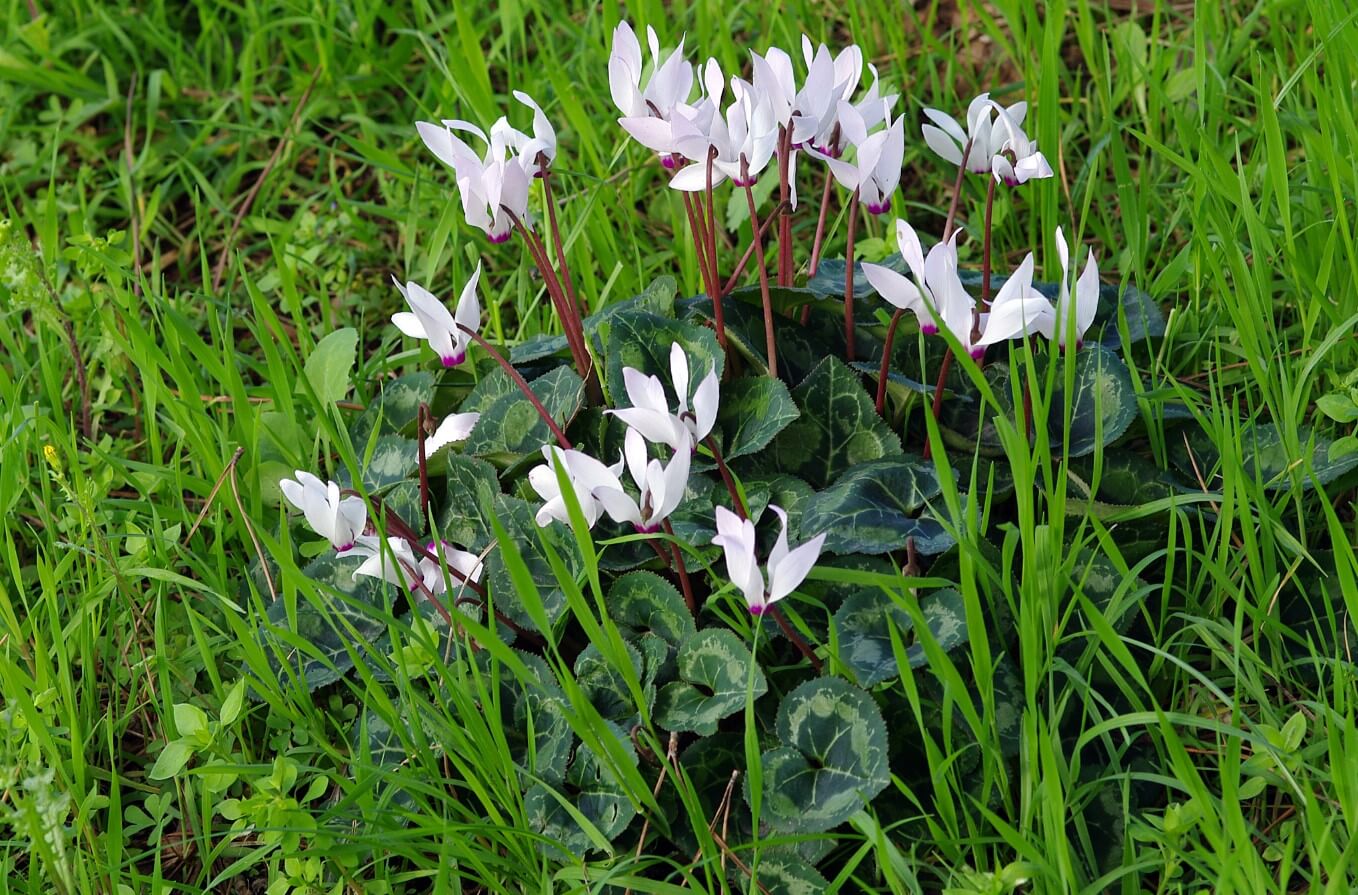
Care for Persian Cyclamen: Watering Your Cyclamen
Watering properly is important for keeping cyclamen healthy. Follow these tips:
- Water when the soil surface feels dry. This is usually every 1-2 weeks.
- Water thoroughly until excess drips from the drainage holes. This ensures the entire root zone gets hydrated.
- Avoid letting the pot sit in water. Always empty the drainage saucer promptly after watering.
- Don’t let the soil get bone dry. This can cause buds and flowers to shrivel.
- Reduce watering frequency as the plant goes dormant. Only water every few weeks once leaves yellow.
The most common cyclamen problems, like wilting leaves and flowers, stem from overwatering. Check soil moisture before watering to prevent issues.
Care for Persian Cyclamen Light Requirements
Persian cyclamen thrive in humid conditions with bright, indirect sunlight:
- East or west-facing windows are ideal spots. They get several hours of gentle morning or afternoon sun.
- Avoid direct hot midday sun which can scorch leaves and flowers. Use sheer curtains to diffuse light from south-facing windows.
- Artificial light can supplement weaker natural light in winter. Use fluorescent grow lights for 12-14 hours per day.
- Keep plants at least 3 feet from hot radiators and heating vents.
Poor lighting leads to leggy, weak growth and few flowers. Move plants to the brightest spot in your home with no direct sun exposure.
Care for Persian Cyclamen Temperature Needs
Cool temperatures between 50-65°F are ideal for cyclamen. Here are some tips:
- Avoid drafty spots like near exterior doors.
- Keep plants away from heat sources like appliances, fireplaces and heating vents.
- Move plants to a cooler room at night if daytime temps exceed 65°F.
- A windowsill in a chilly room is often the best spot.
High temperatures above 70°F can cause bud drop. The coolest area of your home is best for these plants. Provide plenty of humidity if dry heat is unavoidable.
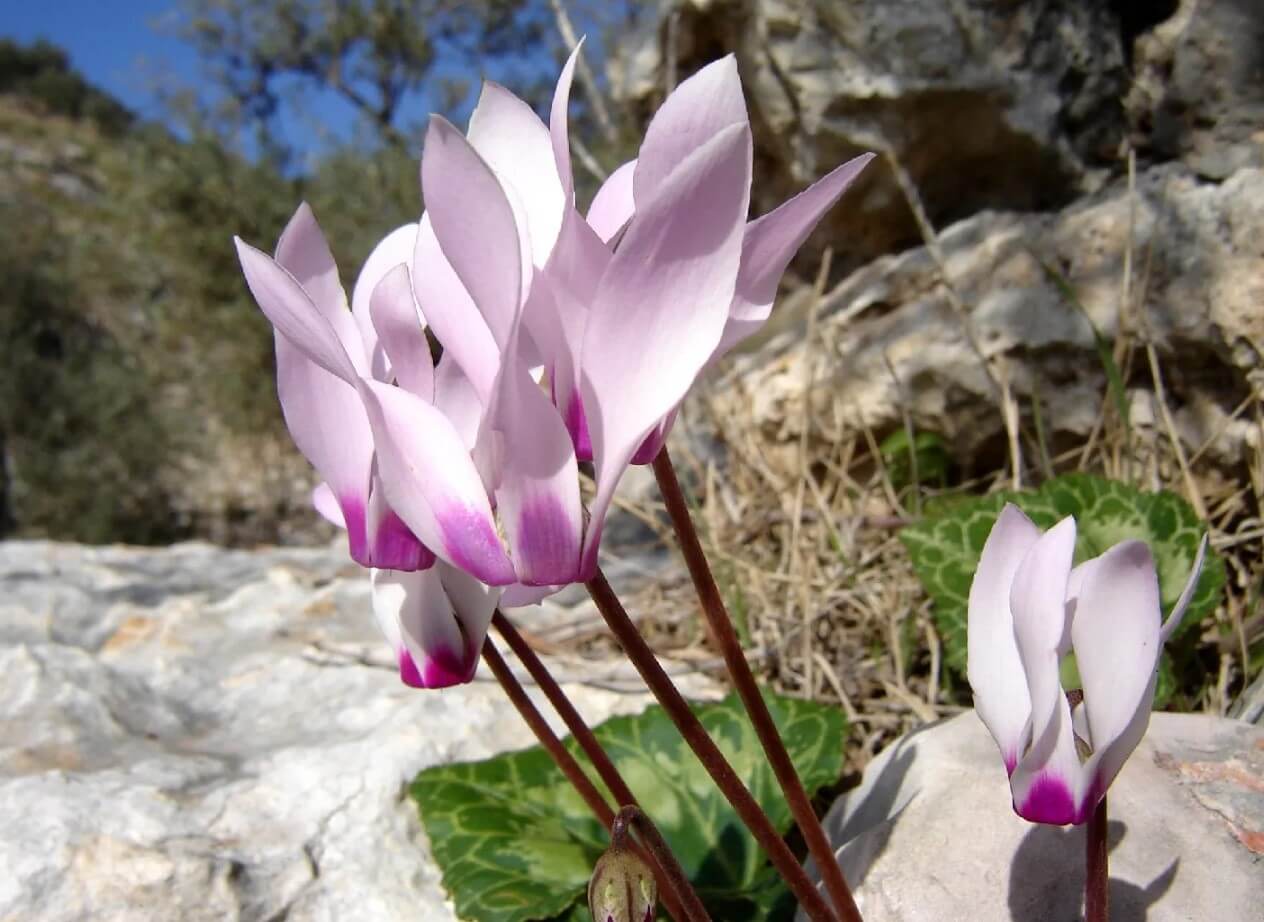
Cyclamen Humidity Needs
Persian cyclamen prefer average to high humidity around 40-60%. Here are some tips:
- Set pots on pebble trays filled with water. This increases moisture around the plant.
- Mist leaves frequently with a spray bottle of water.
- Run a humidifier nearby during dry winter months.
- Avoid placement near heat sources that dry the air.
Signs of low humidity include dry, brown leaf tips and edges. Increase moisture levels if you see these issues.
Repotting Your Cyclamen
Cyclamen prefer to be somewhat pot bound and only need repotting every 2-3 years. Follow these tips:
- When to repot – After flowering finishes in late spring when the plant goes dormant.
- Pot size – Move up just 1-2 inches bigger than the current pot. Avoid oversized pots.
- Soil mix – Use a general houseplant potting mix. Ensure the soil drains well.
- How to repot – Carefully remove the plant and loosen tangled roots. Place in new pot and fill with soil. Press down gently around the base.
Potting too large leads to root rot. Go up just one pot size at a time when repotting dormant cyclamen.
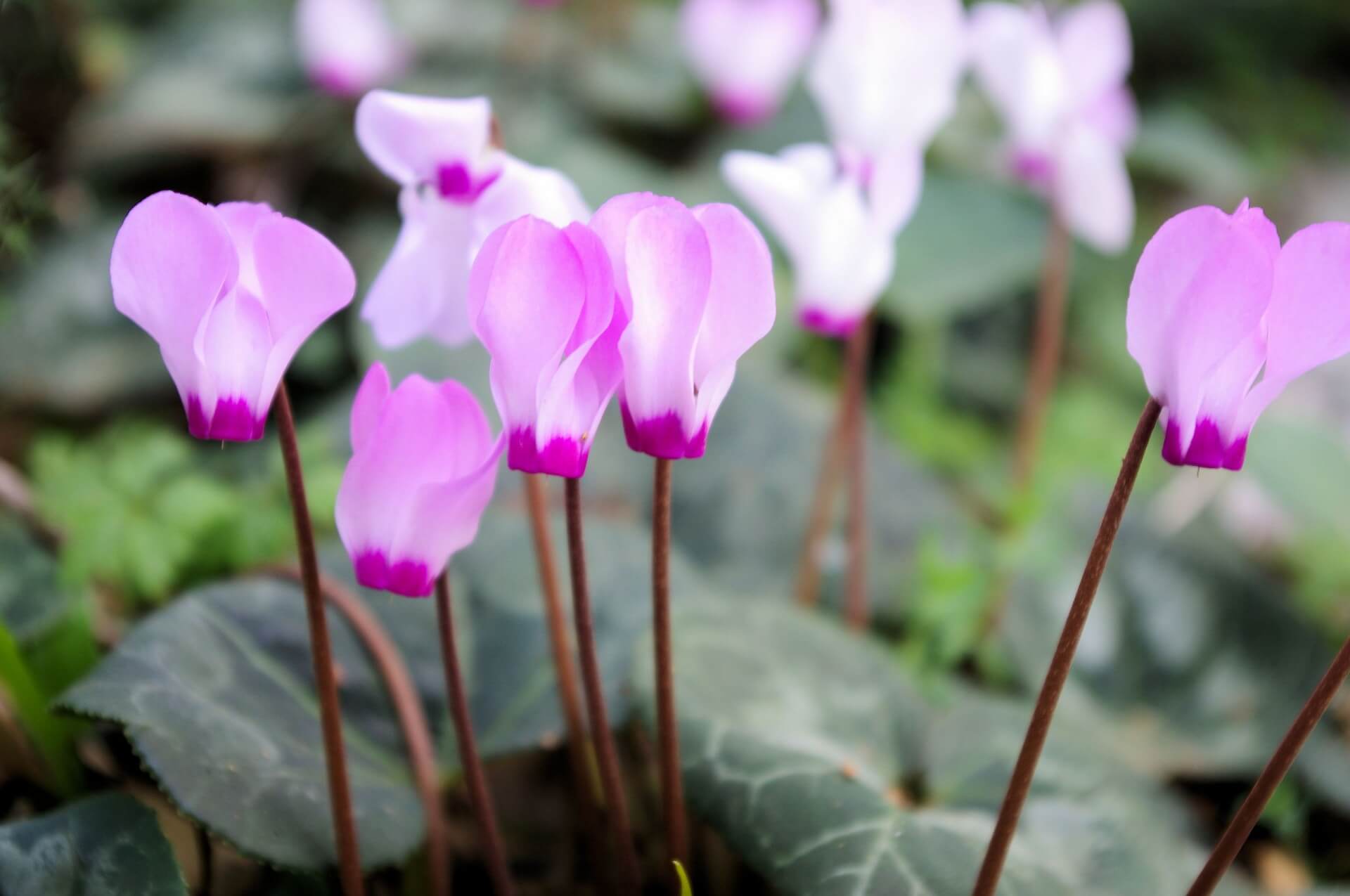
Cyclamen Flowering
One of the joys of growing cyclamen is their showy blooms that appear in winter. Here are some tips for the best flowers:
- Cool fall temperatures trigger blooming. Plants kept above 65°F may not flower well.
- Bud drop can occur if temperatures are too high or the plant is under stress.
- Older tubers produce the most blooms. Small new plants bloom lightly.
- Remove spent flowers by twisting them off to encourage new buds.
- Flowers come in white, pink, red and purple. Mini cyclamen have smaller blossoms.
Once your cyclamen has finished flowering it will go dormant. Leave it alone in a cool spot until new growth resumes in fall.
Cyclamen Dormancy Period
Persian cyclamen grow actively in fall and winter, then become dormant in summer. Follow these tips for this resting period:
- Stop fertilizing and decrease watering as leaves and flowers fade in late spring.
- Remove old flower stems and let the leaves yellow and shrivel up.
- Place the dormant plant in a cool, dark spot like a basement or closet.
- Only water every few weeks to keep tuber from drying out completely.
- Don’t discard the plant if it loses all leaves and looks dead. It will regrow when cooler weather returns.
- Resume normal care when new growth appears in early fall.
The dormancy period is vital to cyclamen health, allowing the plant to recharge for the next blooming cycle.
Propagating Cyclamen
You can propagate new cyclamen plants from seeds or by dividing tubers:
Seed propagation:
- Get cyclamen seed pods from a nursery or collect your own once flowers fade.
- Sow seeds in pots using a well-draining soilless mix. Cover lightly with soil.
- Keep seed pots in a cool spot with temperatures around 60°F.
- Germination takes 1-2 months. Thin seedlings once they sprout.
Dividing tubers:
- Divide congested tubers carefully using a sterile knife after flowering finishes in spring.
- Ensure each division has roots and a growth bud present. Soak divisions in water briefly before replanting.
- Plant tuber divisions in small pots using fresh houseplant potting mix.
- Grow on plants until they establish a good root system before repotting into larger containers.
Both seed and tuber propagation allow you to expand your cyclamen collection. Gift extras to fellow gardening friends.
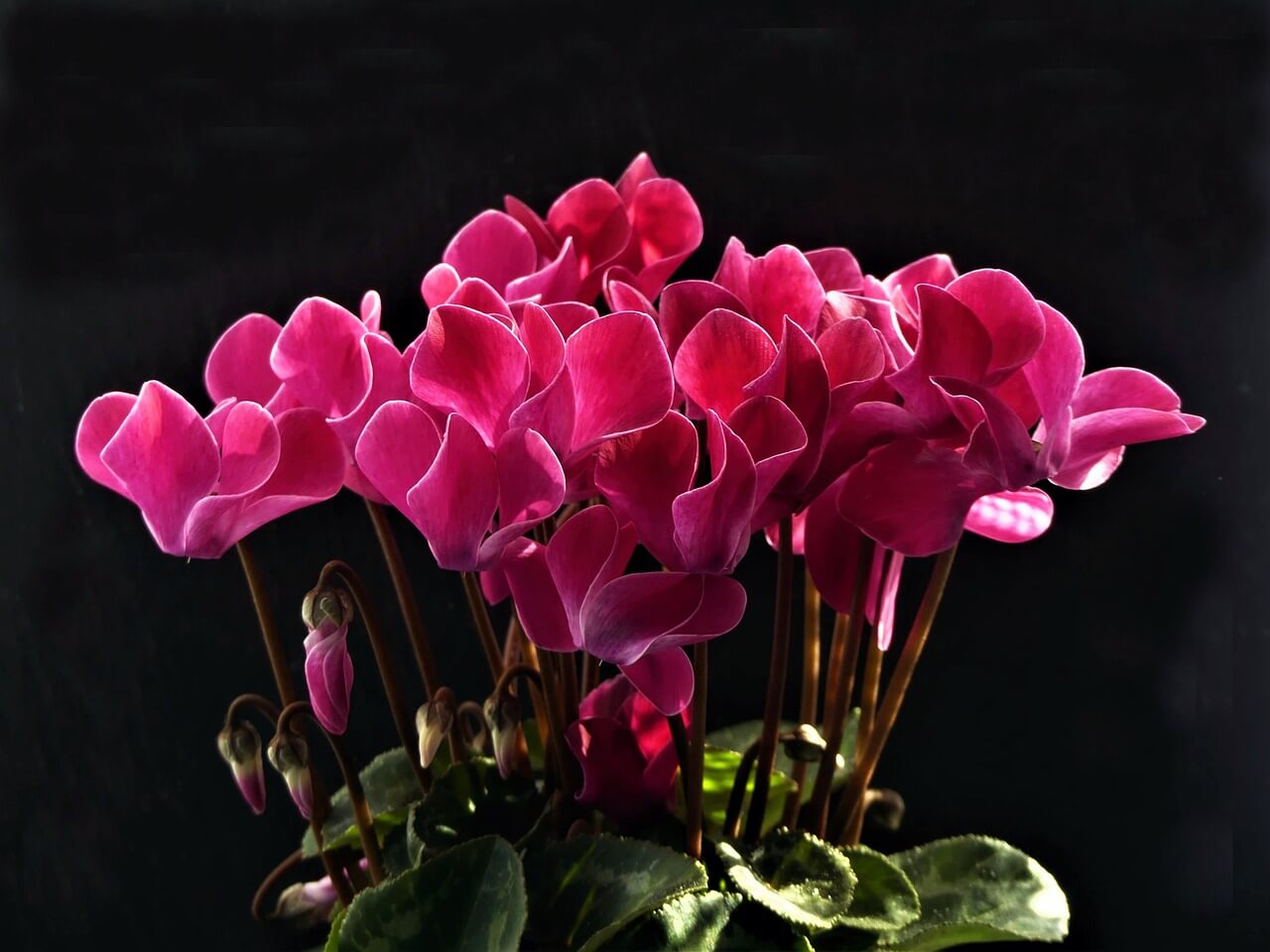
Common Cyclamen Problems
Growing cyclamen plants does come with some challenges. Here are some common problems and how to fix them:
Wilting leaves – Usually caused by overwatering or high temperatures. Allow soil to dry out between waterings and move plant to a cooler spot.
Bud and flower drop – Results from stressors like excess heat, drought, or sudden temperature changes. Try to keep conditions stable.
Leggy growth – Indicates insufficient light. Supplement with a grow light or move to a brighter location.
Leaf spots or blights – Can be caused by bacteria and fungi. Improve airflow and use a fungicide spray. Remove affected leaves promptly.
Root rot – Caused by overly wet soil. Repot in fresh mix and water only when the top few inches of soil have dried out.
Pests – Common issues are aphids, thrips, vine weevils and cyclamen mites. Treat with horticultural oils or insecticidal soaps.
With proper care, most cyclamen issues can be prevented or corrected so your plant stays healthy.
Care for Persian Cyclamen Pests and Diseases
Like other houseplants, cyclamen can be affected by insect pests and plant diseases. Here are some common problems:
Insects:
- Aphids – Small sucking insects that cause distorted growth. Wipe off or use insecticidal soap.
- Thrips – Tiny bugs that rasp leaves and spread viruses. Apply spinosad thrip killer.
- Vine weevils – Weevils and larvae eat leaves and roots. Use parasitic nematodes.
- Cyclamen mites – Microscopic mites that distort leaves and flowers. Apply insecticide early.
Diseases:
- Botrytis blight – Gray mold caused by fungus. Improve airflow to dry leaves. Prune affected parts.
- Root and crown rots – Caused by overwatering. Repot in fresh soil and reduce watering.
- Bacterial soft rot – Bacteria cause leaves to soften and collapse. Remove infected leaves promptly.
- Viral diseases – Spread by pests like thrips. Control insects and rogue infected plants.
Isolate sick plants to prevent spreading issues. Disinfect pots and tools to limit disease transmission.
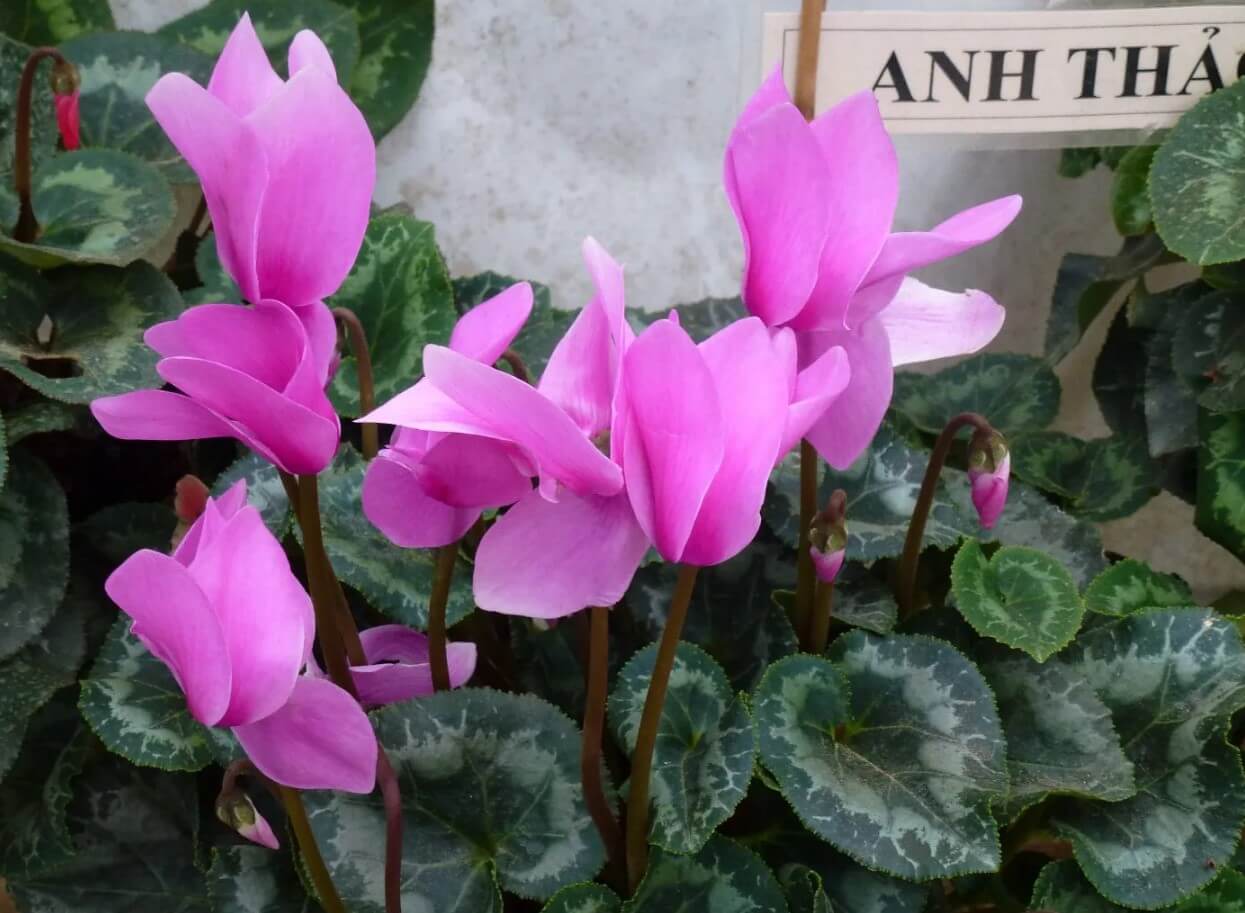
Overwintering Dormant Cyclamen
If cared for properly, cyclamen tubers can be overwintered and rebloomed every year. Follow these tips:
- Allow the plant to go fully dormant in late spring. Leaves will yellow, wither and fall off.
- Cut back flower stems and stop watering once dormant.
- Store the bare tuber in a cool place around 50°F over summer. A basement or refrigerator works well.
- Check tubers occasionally and water lightly to prevent shriveling.
- In early fall, repot in fresh mix. Water sparingly at first then more as growth resumes.
- Move the plant to a bright, cool spot to trigger flowering.
With proper overwintering care, cyclamen can rebound and flower again for many years. Discard any tubers that rot or fail to revive.
Bringing Cyclamen Back Into Bloom
If your cyclamen isn’t blooming well or at all, try these tricks:
- Provide bright indirect light to initiate flower buds. Supplement with grow lights if needed.
- Keep daytime temperatures around 60-65°F and nights cooler. Avoid excess heat.
- Water thoroughly when the soil surface is dry to the touch. Mist leaves often.
- Feed monthly with a diluted houseplant fertilizer during active growth periods.
- Repot in fresh potting mix if the current soil is depleted.
- Remove faded flowers promptly to encourage new blooms.
- Give the plant a dormancy rest period in summer to rejuvenate tubers.
With cyclamen, blooming is linked to cool temperatures and adequate dormancy. Focus on providing the proper care outlined above to achieve the best flowers.
Fun Varieties of Cyclamen Plants
Beyond the traditional pinks and reds, there are many fun cyclamen varieties to grow:
- Mini cyclamen – Dwarf types under 6 inches tall, perfect for terrariums anddish gardens.
- Novelty forms – Fringed, double, and rosebud shaped blooms.
- Variegated types – Foliage accented with white and silver. Tends to be less hardy.
- Fragrant varieties – Some have noticeably fragrant blossoms, especially whites.
- Christmas cyclamen – Festive red and white holiday blooms.
- Color mixtures – Recent hybrids in shades of purple, lavender, magenta and more.
Try new cyclamen types to add variety to your collection. Shop for tubers while they are in bloom to see flower shape and color. Plant together with other flowering houseplants for a beautiful winter display.
With its sweet-scented flowers and attractive leaves, it’s easy to see why the Persian cyclamen has remained a cherished houseplant for over 150 years. Following the care tips above will keep your cyclamen thriving and blooming season after season.
